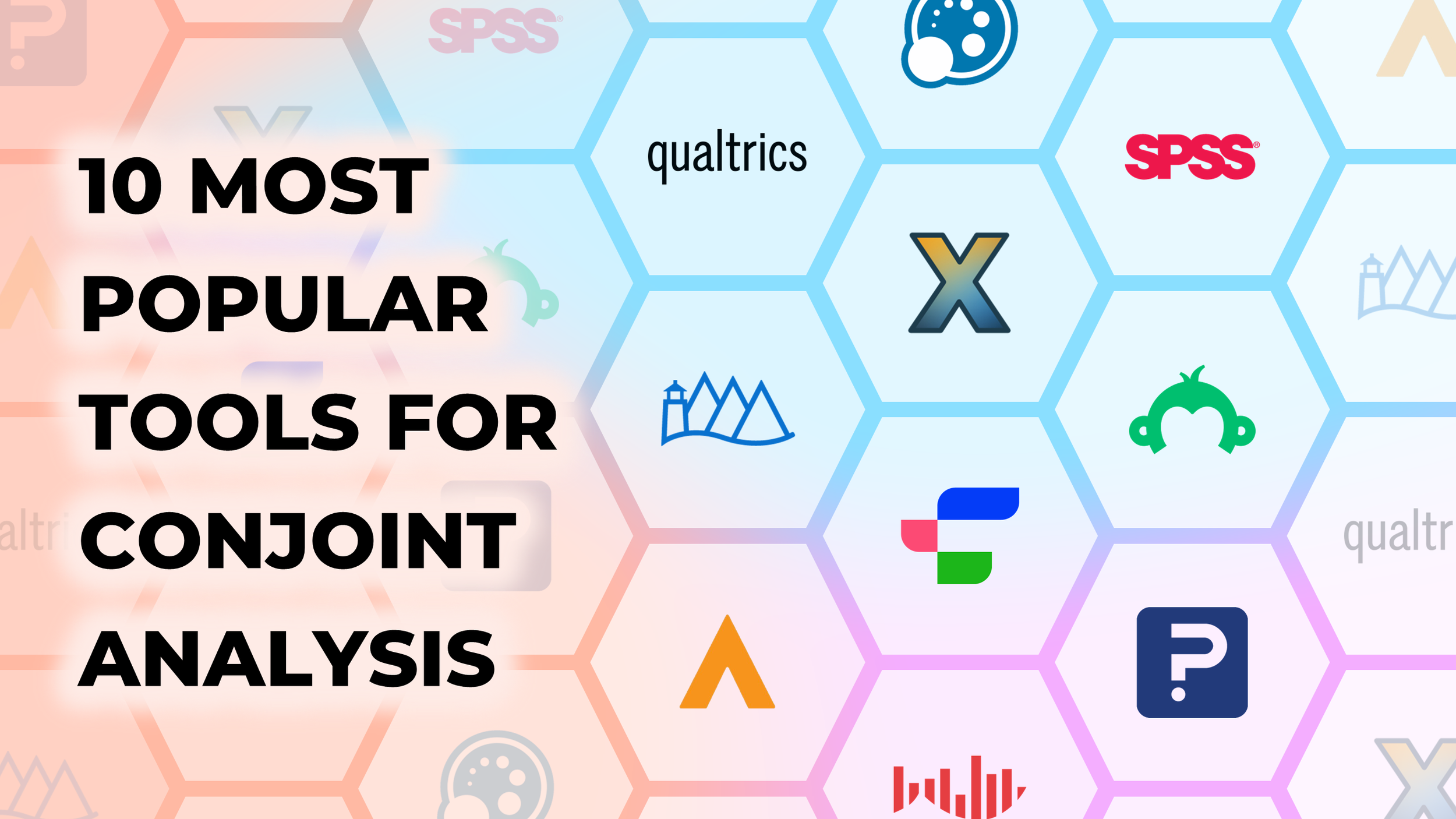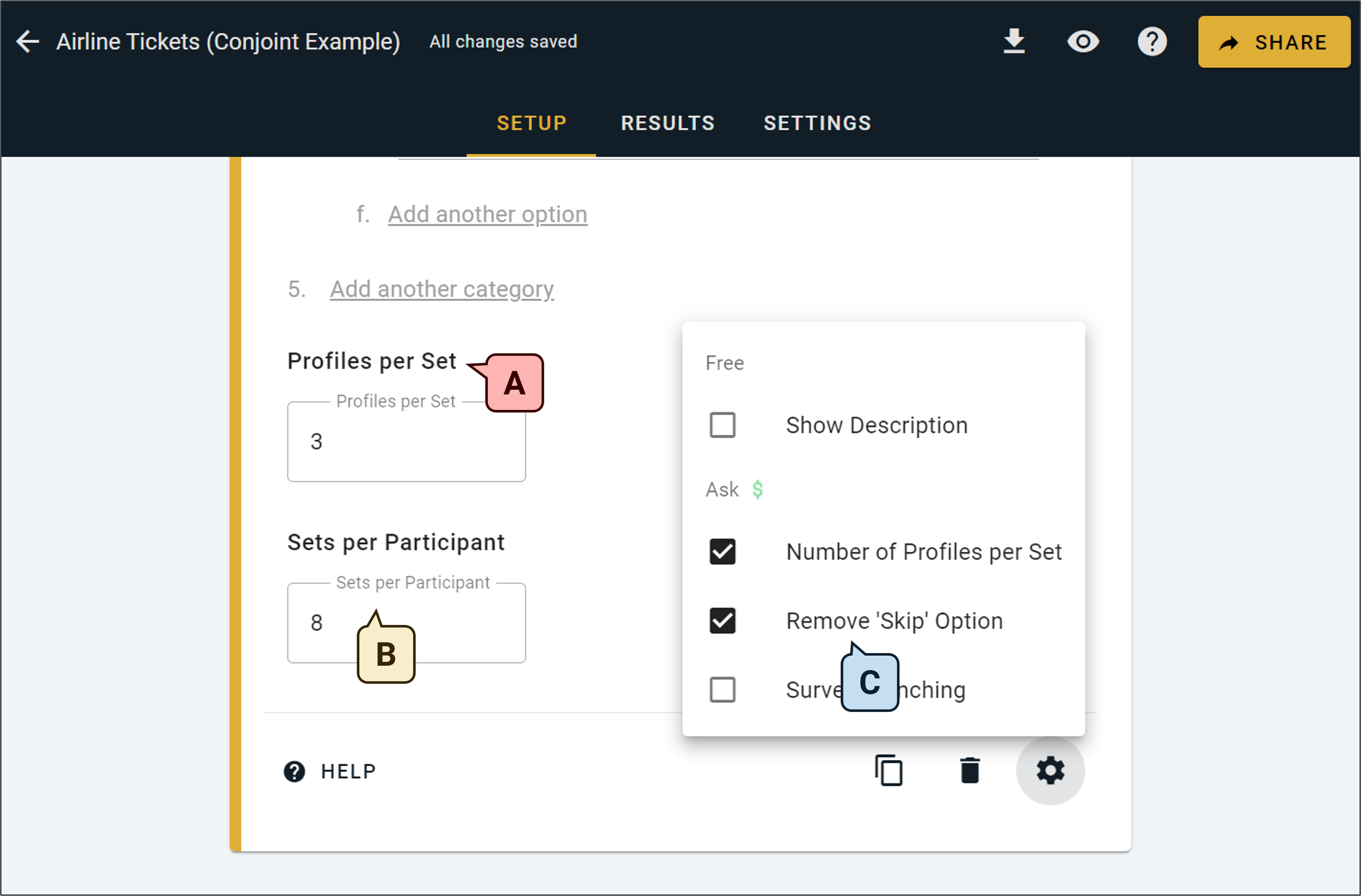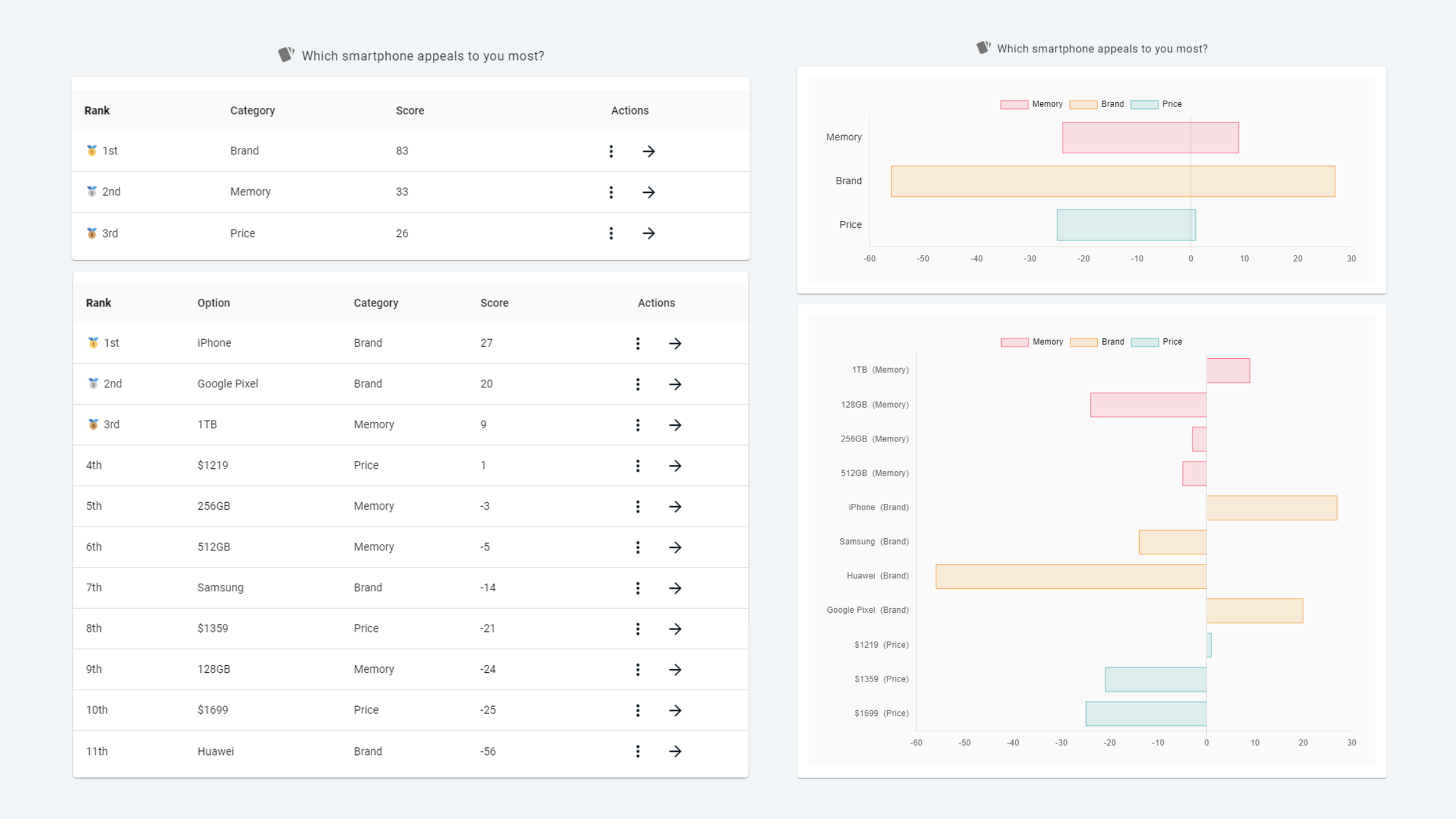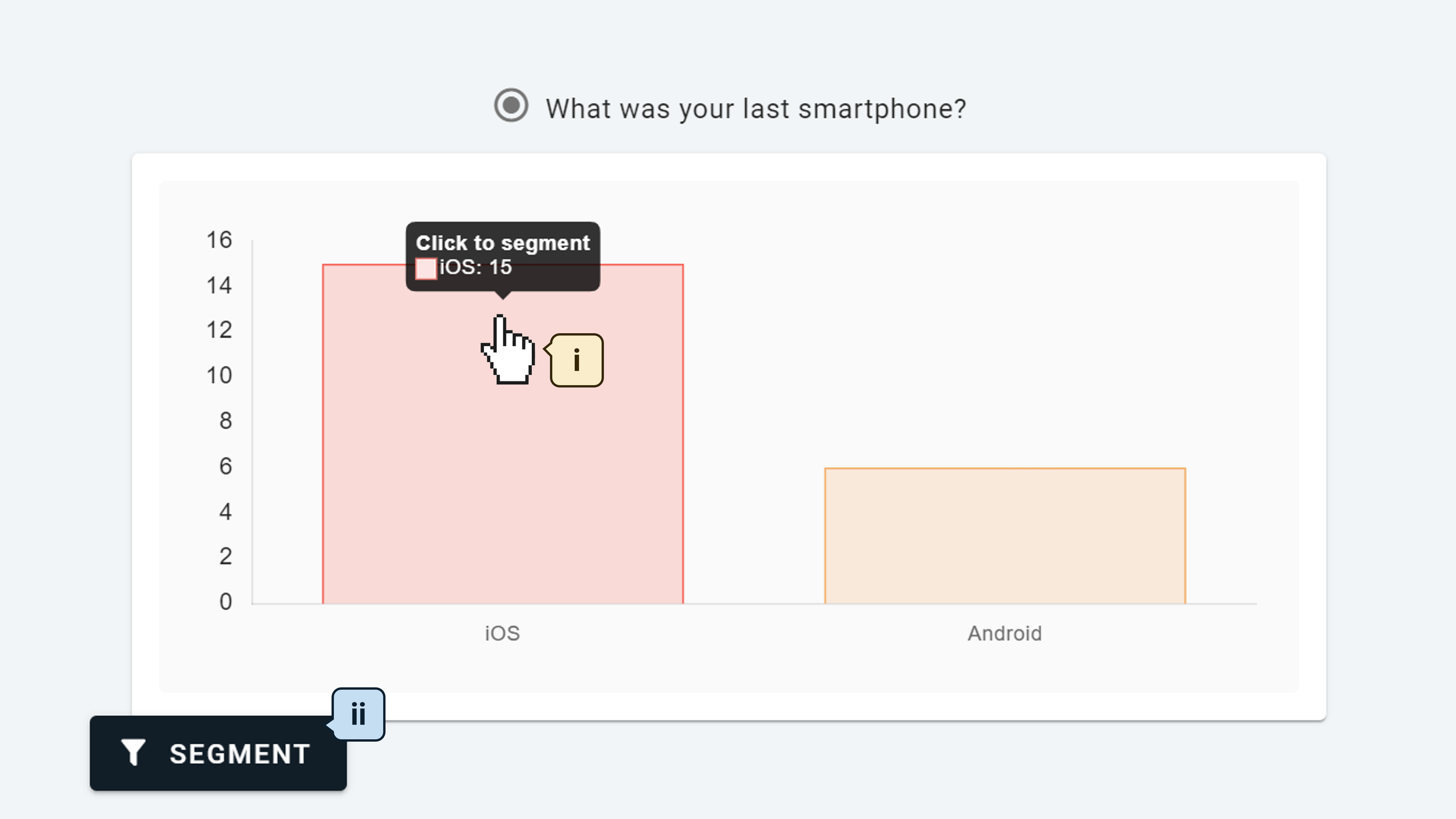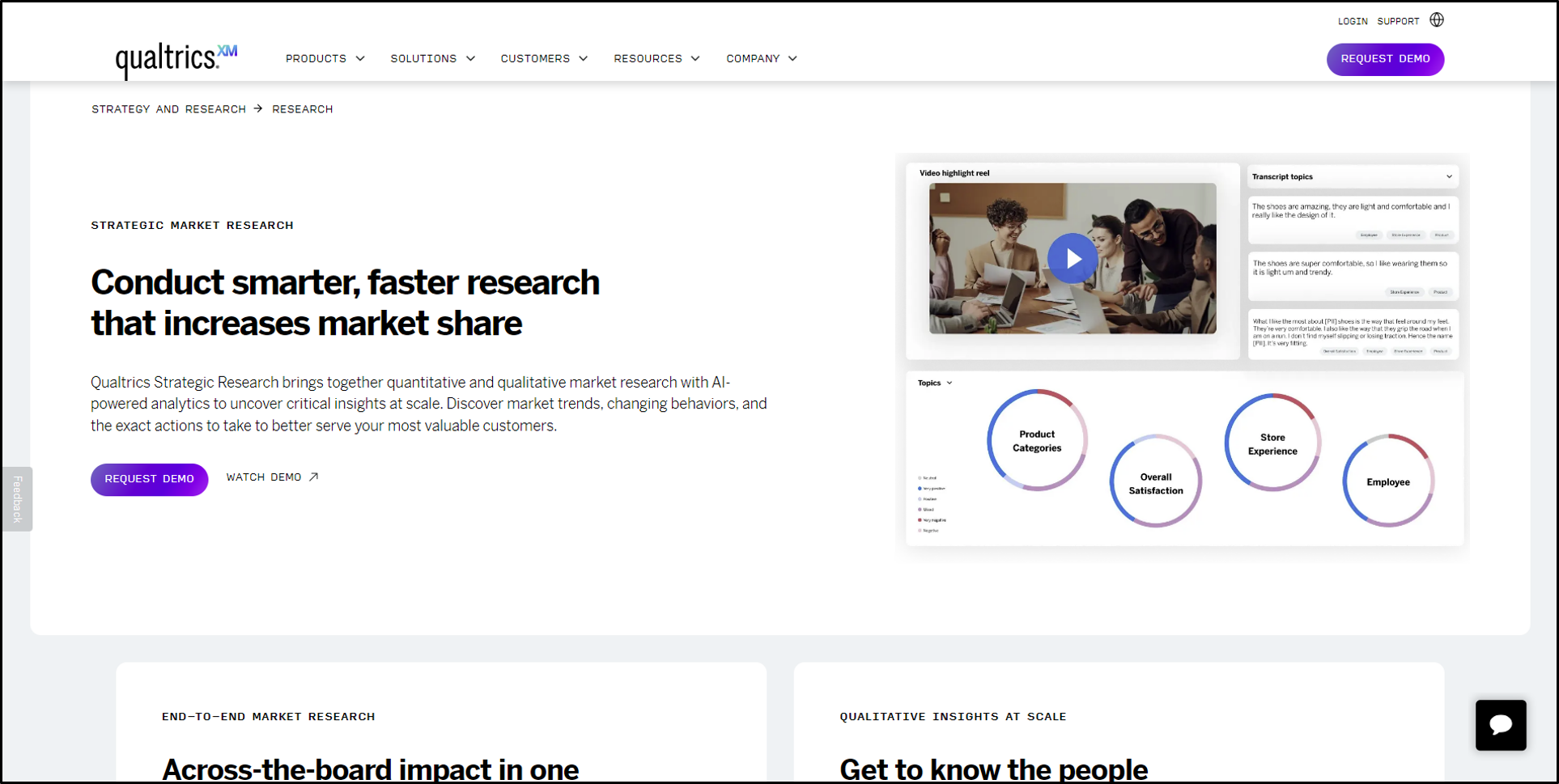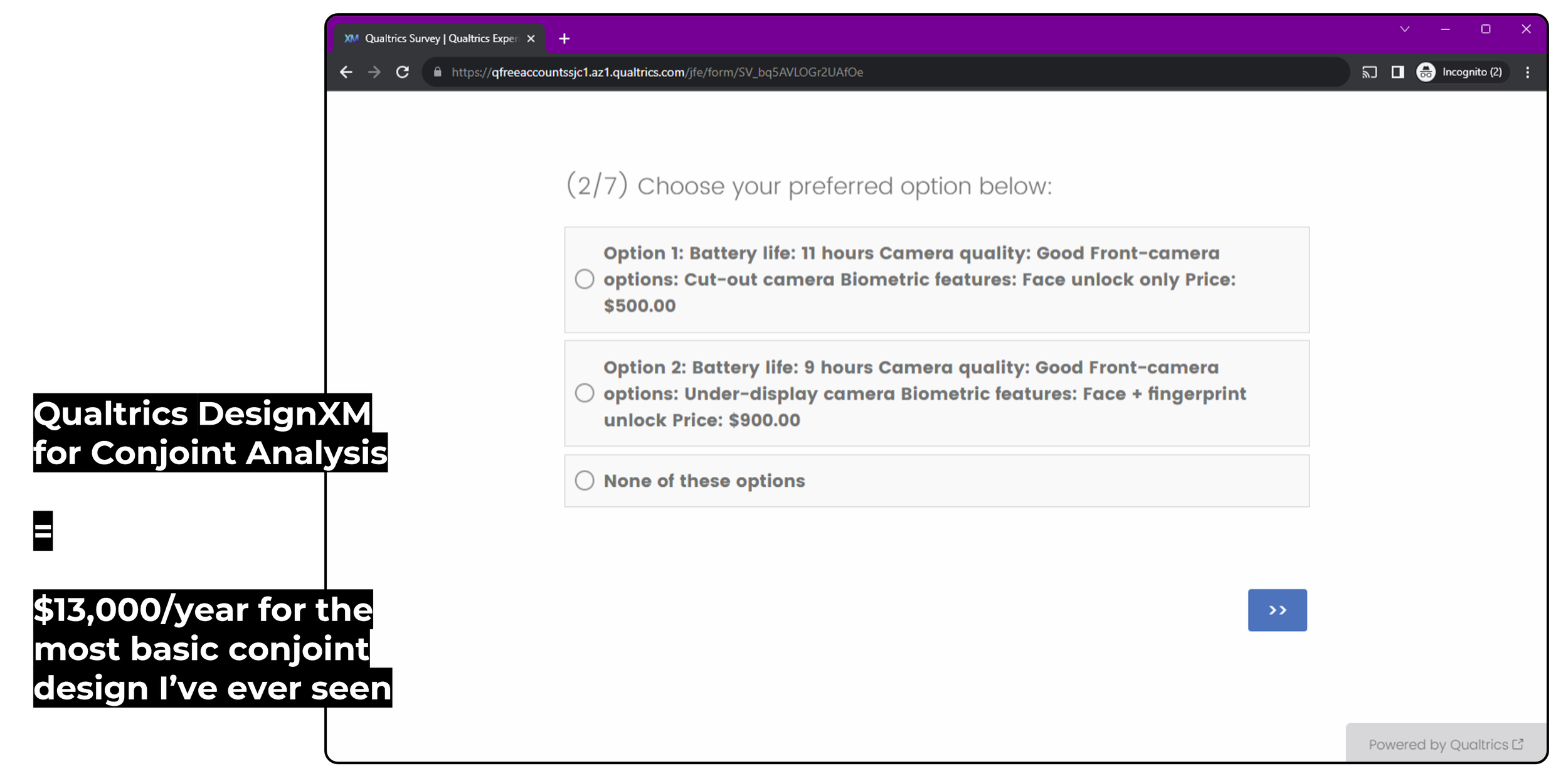10 Most Popular Conjoint Analysis Tools (Free vs Paid)
Conjoint
analysis is a popular research method for understanding
which product attributes are most important to customers
when they’re comparing options during a purchase
decision.
A range of research platforms offer
conjoint analysis surveys, from free self-service survey
tools to $30,000/year advanced analysis platforms that
require expert consultants to manage your studies for
you.
This blog post is an in-depth review of the 10
most popular tools for conjoint analysis. It includes
pricing details, product limitations, survey screenshots,
and specific suggestions to help you pick the platform that
best suits your research needs. While uncommon, there are
free tools for conjoint analysis, so if you’re keen to find
platforms that you can personally test before buying, then
this is the right review guide for you.
Before
jumping in, here are a series of free resources to help you
learn more about conjoint analysis before you start
designing your own conjoint survey:
Ultimate Guide to Conjoint Analysis (Explanation, Tools, Examples)
13 Types of Conjoint Analysis (Explained with Image Examples)
8 Alternative Survey Methods To Use Instead Of Conjoint Analysis
How your Conjoint Analysis results are calculated (advanced guide)
Ok, that’s enough introductory small talk — let’s jump to the reviews!
10 Most Popular Tools For Conjoint Analysis
1. OpinionX
2. Pollfish
4. SurveyMonkey
5. SPSS
7. QuestionPro
8. 1000minds
9. Conjointly
10. Alchemer
— — —
1. OpinionX
OpinionX is a free
survey tool for ranking people’s preferences and priorities that’s
used by thousands of teams from companies like Google, Amazon, and
Shopify. It is the only survey tool that offers unlimited conjoint
analysis surveys with unlimited participants for free.
Unlike
other survey tools, OpinionX’s conjoint analysis question has been
designed specifically to be easy to use on small touchscreen phones.
The profiles are responsive in shape and can be stacked horizontally
or vertically to suit the participant’s screen size. Attribute
titles are shown as small headers above each level/option so that
respondents on mobile phones do not have to scroll over and back
repeatedly to recontextualize the meaning of the text displayed on
each profile.
Try an OpinionX conjoint survey for yourself by
using the interactive demo below:
⬆️ interactive demo ⬆️
Let’s look closer at how OpinionX works, a breakdown of its pricing plans, and specifically the functionality it offers for conjoint analysis.
How does OpinionX work?
OpinionX has two main
areas of value: (1) ranking surveys and (2) segmentation analysis. It
comes with a range of ranking methods, including Pairwise Comparison, Ranked Choice Voting,
Points Allocation, Image Ranking, MaxDiff Analysis, Consensus Voting,
and Conjoint
Analysis. All of these ranking methods, along with normal survey
formats like multiple-choice questions and open text-response boxes, are
completely free to use with no limit on the number that can be included
per survey.
Segmentation analysis on OpinionX, available via the
Analyze plan, offers multiple ways to filter, compare, and analyze your
ranked results to see how groups of similar people voted differently
from everyone else. This kind of analysis is the most important part of
any conjoint research — you’re not just looking to see which attributes
are most important to customers, you’re trying to see which attributes
are most important to your most important customers.
OpinionX’s
segmentation features are designed to populate
automatically — you don’t need to be a data scientist to configure them
or figure out what they mean. They are intuitive to use, with built-in
diagrams, helpful popups to explain what things mean, and simple buttons
to help you pick the segments you want to analyze. OpinionX helps you
independently conduct the kind of research that your teammates will
think you hired a specialist researcher to do for you!
What are OpinionX’s pricing plans?
OpinionX has
four product tiers — Free, Analyze, Accelerate, and Advanced.
The
Free tier offers
unlimited surveys, each with unlimited participants. You can also invite
unlimited teammates to join your workspace on OpinionX and each of them
can create surveys of their own for no additional per-seat fee. All
question types are unlocked on the free tier of OpinionX. Some premium
features are not available, such as advanced analysis or configuration
options, which are outlined in the paragraphs below. Overall, OpinionX’s
free tier is one of the most generous
of any survey tool available on the entire internet.
The Analyze tier
unlocks survey setup customizations and analysis features. The setup
customizations include things like conditional branching, forced
response (no ‘skip’ button), and prohibited pairing logic (prevent
certain levels from appearing in the same conjoint profile). The
analysis features include exporting, segmentation filters, and even
AI-powered clustering into personas that voted similarly. The Analyze
tier starts at $100 and is available in a pay-per-survey model as well
as a yearly subscription for unlimited premium surveys.
The Accelerate tier
offers advanced security (SAML SSO, privacy settings), priority support,
and 10 hours of prepaid research consulting services, along with a range
of other
benefits. For organizations rolling OpinionX out at scale,
either with high-volume surveys or a large team workspace, the Advanced tier
allows for customized pricing plans that suit your exact needs.
How does Conjoint Analysis work on OpinionX?
Every OpinionX survey, whether it’s a conjoint analysis project or otherwise, is a process of three parts: (1) Setup, (2) Distribution, and (3) Analysis.
1. Setup
Setting up a Conjoint Analysis survey on OpinionX is very easy and has been designed so that anyone, regardless of research experience, will be able to successfully get their project started. When you create your OpinionX survey, you’ll be asked to pick your first survey “block” (aka question or survey step). Conjoint analysis on OpinionX is known as the “Profile Rank” block:
Once your Profile Rank block has loaded, you’ll see three different text input options: (i) question, (ii) category, and (iii) option. Here’s what each of these text fields look like on the final survey:
Note that on OpinionX, we use some
slightly different terminology to how academics describe conjoint analysis to try
make it easier for people to understand how conjoint analysis works. We call
conjoint attributes “categories”, attribute levels are called “options”, and
part-worth utilities are simply called “scores”. We believe that the terms we chose
are more accessible and therefore will help to open conjoint analysis as a more
usable research method for a greater number of people. Feel free to use whichever
terminology you’re more comfortable with, if you contact us for help with your
survey, we will understand what you mean either way :)
After adding your list
of categories and options, you’ll want to customize your Profile Rank block’s
configuration. There are three important ways you can do this:
A. Profiles per Set → How many
profiles do you want to show at the same time when participants are voting? In the airline
example from the screenshot, you can see that there are three profiles on screen. You can
set this number to whatever you’d like, however it is recommended to pick a number between 2
and 6 (the more complex your categories/options, the lower this number should be). Note that
this is set to a default of 2 for all users and can only be customized by customers on
OpinionX’s Analyze pricing plan or higher.
B. Sets per Participant →
How many times do you want each participant to vote? In the airline example, I’ve put the
Sets per Participant to 8, meaning that participants will need to select their preferred
“ticket” eight times before they can proceed to the next part of the survey. You can set any
number you want here, regardless of whether you’re on the free version or a paid
plan.
C. Skip Button → I
personally like using forced voting for my conjoint surveys by removing the ‘Skip’ button,
however you can leave the skip button there if you want to avoid forcing participants to
select profiles that they don’t actually like.
Once you’ve got your Profile Rank block ready to go, it’s time to add any other questions to your survey that you want participants to answer. You can add as many other questions to your survey as you’d like by clicking the “+ Add Block” button that floats alongside the top-right corner of the block you’re currently editing. All question types are available for free on OpinionX.
The most common three question types that get added to conjoint analysis surveys are:
i. Email Identify → Using
OpinionX’s Identify block type, they collect participants’ emails (or name,
username, ID number, etc.) so that they know who has participated so far and to prevent
duplicate respondents.
ii. Multiple Choice → If you
want to filter and compare segments of participants later on (eg. to see the differences between
high schoolers vs university students or Americans vs Europeans), the easiest way to do this is
to include Multiple Choice questions in your survey that allow participants to
self select which segments they belong to. Then when it comes to analysis, you’ll be able to
filter and compare these groups in literally one click.
iii. Text Response → Want to
understand why people voted the way they did or whether your conjoint was missing any important
categories/options that are important to people’s purchase decisions? Including a Text Response block to allow people to add new questions is the best
way to identify gaps in your current knowledge about the topic you’re researching.
If in doubt, check out this 90-second Getting Started video that shows exactly how to create and launch your survey on OpinionX.
2. Distribution
There are four common ways to distribute a conjoint survey:
A. Shareable Link → Grab the
generic survey link by clicking the big “Share” button in the top-right corner of your survey
dashboard. You can use this link however you’d like — share
it on Twitter, Reddit, or LinkedIn, put it in an email newsletter going out to all your
users, or link it in a popup or banner inside your product.
B. Embedded iFrame → Add your
OpinionX survey as an embedded widget on any web page by using our pre-built iframe. This is how
I embedded the interactive conjoint analysis survey that you saw earlier in this blog post with
the lilac-colored frame!
C. Email Invites → Import a
list of email addresses and send each person a unique link that can only be used once. If you’re conducting a
conjoint analysis study of a sensitive nature, this is the best way to make sure that people
cannot complete your survey multiple times. OpinionX charges $0.10 per email sent.
D. Buy Participants → If you
don’t have access to a pool of potential participants, you can always use a third-party service
to recruit people to complete your survey. On these recruitment services, you pay a fixed fee
per participant as an incentive for them to complete your survey. I personally recommend using
Prolific,
as it has a high-quality audience and is very easy to set up alongside your OpinionX survey.
3. Analysis
Once participants start to complete your survey, you’ll see their responses appear automatically on your Results page. Conjoint results on OpinionX are displayed in two formats that you can switch between — Table and Chart.
3a. What do the scores mean?
The
score for each option indicates the likelihood that a profile will be picked if that specific option
is displayed on it (-100 means it is certain it won’t be picked, +100 means it is certain that it
will be picked).
The score for a category is the difference between the highest and lowest
option scores within that category. For example, in the screenshot above, the highest score for an
option in the “Brand” category is iPhone (27) and the lowest is Huawei (-56). The difference between
these two scores is 83 points, which is the score for the “Brand” category.
This is an
important nuance. While the scores for options show the relative importance each option has for
participants trying to decide between profiles, the score for categories shows the degree of
influence that a category has over the decision. A bigger category score isn’t always a good thing,
so it’s important to look at the option scores within that category to understand how the category
score is being calculated. Looking at the visual chart for category scores is a good way to quickly
interpret this nuance!
3b. How can I use these scores?
You
can use the option scores to create hypothetical profiles and estimate which has a higher chance of
being picked as the more preferred by a potential customer. For example, let’s use some scores from
the smartphone conjoint results in the screenshot above:
In the above example, I put the top-ranked brand
(iPhone) together with the lowest-ranked options for Memory and Price. Then I created a competing
profile with the lowest-ranked brand (Huawei) but the highest-ranked Memory and Price. Huawei was so
disliked by voters that this still did not even nearly give it a strong enough combined score to
come close to beating the iPhone profile — the results predict that two-thirds of participants will
still pick the low-spec expensive iPhone over the high-spec affordable Huawei (22-(-46) = 68% chance
of selection).
3c. How do I segment conjoint analysis results to compare different groups?
There
are three ways you can segment your results on OpinionX which are all unlocked on the Analyze
tier.
The first segmentation method is a simple one-click
filter. Go to the results bar chart for any multiple choice or rating scale question and
click the bar for the segment you wish to isolate. This will recalculate the entire results page to
only include the participants who are part of this group. Alternatively, you can click any “Segment”
button that you’ll find throughout the results pages to open the segment configuration panel where
you can set more advanced filters (like using AND/OR logic).
The second method for segmenting your conjoint analysis results on OpinionX is the head-to-head comparison view. At the top of the survey dashboard, switch to the Compare Tab and define your two segments. This will allow you to see the results for your two segments side by side, making it easier to see specific differences (eg. in the screenshot below, the iPhone is unsurprisingly the top option for current iOS users, whereas it is 10th out of 15 options for current Android users — this is the biggest gap in score between the two segments for any option).
The third segmentation method is the Segments Tab, which shows a breakdown of scores for each segment in one color-coded table (ie. a crosstab heatmap visualization). The example below is quite a simple version with just two segments shown, but you can load up to 20 different groups into this table at the same time. The color coding helps to make patterns visible or anomalies stand out. One interesting takeaway from the screenshot below is that iOS users are more likely to be open to picking a Google Pixel (+10) whereas Android users are very resistant to the idea of picking an iPhone (-18).
That’s a whistle-stop tour of conjoint analysis on OpinionX! Here’s a quick reminder of the most important points:
OpinionX is the only survey tool that lets you have unlimited participants in your conjoint analysis studies for free.
It comes with a range of other free survey and ranking methods that you can combine with your conjoint analysis survey.
OpinionX’s paid plans are as cheap as $10/month and there are no per-seat, per-participant, or per-survey fees — no matter how much you use it.
OpinionX has a range of advanced analysis features that are built to be easy to understand and use, even for people who are not experienced professionals.
Unlike many professional research tools, OpinionX is not trying to get you “in the door” with cheap pricing just to then hit you with expensive expert consultants that you’ll need to hire to complete any projects. Instead, OpinionX is designed to be easy to use, easy to understand, and easy to succeed with independently.
Join the tens of thousands of teams already using OpinionX to measure what their customers care about most. Sign up to OpinionX for free and create your first conjoint analysis survey in less than five minutes.
— — —
2. Pollfish
Discrete-Choice Formats: Conjoint Analysis and MaxDiff Analysis.
Free Plan:Conjoint questions are not included in any free plan or trial.
Price:$30,000 for the Elite tier.
Pollfish has a pool of 250M
respondents across 160+ countries, which allows researchers to quickly source participants for their
surveys. Conjoint
analysis is only available on the “Elite” plan of Pollfish, which starts at $30,000/year as
an “upfront deposit”. Survey participants are billed at $0.95 plus incentives and recruitment fees.
The Elite plan is targeted specifically at professional research clients and agencies. They have an
“Elite SMB” version for small to medium-sized businesses that starts at $12,000.
Conclusion:
Suitable for high-volume researchers that need access to a global recruitment panel 🟠
— — —
3. Qualtrics DesignXM
Discrete-Choice Formats: Conjoint Analysis and MaxDiff Analysis.
Free Plan:DesignXM free trial does not include Conjoint or MaxDiff questions ❌
Price:$13,000 ($5,000/year for one CoreXM user + $1/respondent + Conjoint add-on).
Qualtrics is an expensive solution for running conjoint analysis surveys. The minimum price annual price works out to roughly $13,000 for an annual single-user product license, participant fees (which you must pay even if you source participants yourself), and the add-on for conjoint questions. There’s also no way to try the product or get a pricing quote without engaging with salespeople that will push you into a video call and ask 20+ irrelevant questions before sharing any pricing information. I jumped through those hoops and I think you can still sense my frustration…
I got my hands on a demo version of the Qualtrics
conjoint add-on and, as you can see in the screenshot above, it looks like a developer at Qualtrics
threw together the survey design in just one day back in 2014 and hasn’t looked at it again
since.
Conclusion: Avoid! Expensive tool for a basic and limited version of
conjoint analysis ❌
— — —
4. SurveyMonkey
Discrete-Choice Formats: Seemingly none available despite what their website says.
Free Plan:No conjoint free plan or trial available ❌
Price:$5,000/year for a 2-seat license + Conjoint add-on.
Although SurveyMonkey
claims to offer a conjoint analysis add-on for its Enterprise plan (which starts at $5,000/year for
a 2-seat license), I could not find a single shred of evidence that it actually exists. Their
support bot says it has no information about conjoint analysis and they have ignored all of my
emails asking for more information.
Conclusion: I don’t think Conjoint
Analysis actually exists as a question type on SurveyMonkey… ❌
— — —
5. SPSS
Discrete-Choice Formats: Conjoint Analysis (CBC format only).
Free Plan:30-day free trial.
Price:$23,800 per user (perpetual).
SPSS was first released in
1968 and was acquired by IBM in 2009. With 54,070 companies using SPSS, it is
more than triple the customer base of survey juggernaut Qualtrics. Conjoint is only available on the
most expensive tier of SPSS (named “Premium”), which costs $23,800 per user for a perpetual license.
Conclusion:
Aimed at traditional large enterprises, not tech/startups ❌
— — —
6. Sawtooth Software
Discrete-Choice Formats: Conjoint Analysis (many types) and MaxDiff Analysis.
Free Plan:Demo version available upon request.
Price:$4500/year for their “Professional Tier” which you can test via their free tier (limited to 50 participants).
Sawtooth Software was the
pioneer of online conjoint analysis surveys and has been a major player in the online market
research space for over 30 years. They have a range of expertise in traditional and digital conjoint
research that is hard to compete with. If you plan on hiring their in-house experts alongside their
product, you’ll be in good hands.
Conclusion: Particularly suited for
traditional business categories like consumer goods or those planning to hire expertise alongside a
research product 🟢
— — —
7. QuestionPro
Discrete-Choice Formats: Conjoint, MaxDiff, A/B testing.
Free Plan:Yes but it doesn’t include Conjoint Analysis ❌
Price:$5,000/year for one seat and up to 5,000 responses.
Conjoint analysis is only available on the
Enterprise version of QuestionPro, which
is called their “Research Suite” offering. You pay an initial $5,000, which covers up to 5,000
responses over 12 months. Additional responses can be purchased for $5000 per 5k responses
(bundled). QuestionPro’s product strategy is basically to offer every question format possible, so
it can be a bit of an overwhelming user experience.
Conclusion: Expensive
and complex for a self-serve offering 🟠
— — —
8. 1000minds
Discrete-Choice Formats: PAPRIKA-Based Adaptive Conjoint Analysis
Free Plan:Schedule a demo call or start a free trial.
Price:N/A — annual license calculated on a per-case basis and available only via sales call.
1000minds
is a decision-making tool that was created in 2002. Its primary clients are academics and public
sector bodies that require a bespoke decision-insights platform. 1000minds offers three main
decision-making tools, one of which is their conjoint analysis solution. Their main differentiator
is that their conjoint surveys are built on top of PAPRIKA, a patented method created by the
1000minds founders for ‘partial-profile’ conjoint surveys (ie. using a single-variable method like
pairwise comparison or maxdiff
analysis).
Conclusion: Suitable if you’re open to experimental /
alternative research formats, not the usual or traditional Choice-Based Conjoint Analysis 🟠
— — —
9. Conjointly
Discrete-Choice Formats: Choice-Based Conjoint Analysis.
Free Plan:You can run a “Market Test” conjoint survey for $289 with up to 20 responses.
Price:$1,795/year for one user or $7,995/year for a team account.
Conjointly
is the market leader in conjoint analysis surveys. As the name suggests, they offer a range of
conjoint solutions alongside some other techniques like Van Westendorp PSM and TURF Analysis.
Additionally, Conjointly offers a team of in-house research experts that you can hire for an
additional fee to help you design or analyze your conjoint
project.
Conclusion: Currently the best self-serve solution for research that requires conjoint analysis 🟢
— — —
10. Alchemer
Discrete-Choice Formats: Conjoint Analysis (CBC format only).
Free Plan:7-day free trial.
Price:$3,000 per user for the “Full Access” tier (billed as $275/month).
Alchemer
positions itself in the survey market as a general-purpose, cost-effective SurveyMonkey alternative
(specifically for on small teams) that’s less complex than Qualtrics — it doesn’t necessarily offer
anything groundbreaking beyond that. Pricing plans are limited to 3 people max before per-user
pricing kicks in, so a team of three billed monthly would end up paying $9,000 each year for access
to conjoint questions on Alchemer’s “Full Access” tier.
Conclusion: Viable
“no frills” / budget option for teams that dislike SurveyMonkey/Qualtrics 🟠
— — —
You should not have to pay thousands of dollars for a self-service conjoint analysis tool.
With OpinionX, you can
design, distribute and digest the results of your research without needing to hire an expensive
conjoint expert. You can measure what’s most important to your customers in under 1 hour instead of
spending 1-month’s budget on an advanced tool that’s so complex you won’t even understand how to use
it.
OpinionX may be easy to set up but that doesn’t mean it’s a basic tool — its conjoint
analysis surveys come with conditional branching logic, advanced segmentation filters to compare the
priorities of participant subgroups, and real-time collaboration so that you can invite your
teammates to build your conjoint project alongside you.
Learn more about how OpinionX can
help you measure your customers’ preferences or jump right in and create a free conjoint analysis
survey in minutes.
— — —
Further Reading About Conjoint Analysis:
• Ultimate Guide to Conjoint Analysis (Explanation, Types, Tools, Examples)
• 8 alternatives to conjoint analysis for choice-based comparison research
• 5 criteria for assessing whether conjoint analysis suits your research scenario
• 10 examples of research scenarios that should NOT use conjoint analysis
• 13 types of conjoint analysis explained (with picture examples)
• How to calculate conjoint analysis results in 8 Steps [Advanced]
About The Author:
Daniel Kyne is the
Co-Founder of OpinionX,
a free research tool for stack ranking people’s priorities — used by thousands of product teams to
better understand what matters most to their customers. OpinionX has a bunch of free research
methods for ranking people’s preferences — including Conjoint Analysis and other ranking methods
like Pairwise Comparison and Points-Based Voting.
→ Create a FREE Conjoint Analysis Survey now
Subscribe to The Full-Stack Researcher newsletter where we share research strategies for founders and product teams:

